The Effect of CoAl2O4 as a Nucleating Agent and Pouring Temperature on the Microstructure and Properties of Inconel 713C® Nickel-Based Superalloy Castings
Abstract
:1. Introduction
2. Materials and Methods
3. Results
3.1. Analysis of the Solidification Path and Phase Stability in Inconel 713C®
3.2. Macro- and Microstructure of the as-Cast Inconel 713C® Castings
3.3. Mechanical Properties of Inconel 713C® Castings at Room and Elevated Temperature
4. Grain Refinement Mechanism via CoAl2O4 Inoculant Incorporation
5. Conclusions
- Grain size control in lost-wax Inconel 713C® castings can be performed by changing the melt-pouring temperature and CoAl2O4 contents in the prime coating of the shell mold. The most significant grain refinement was achieved in casting H10, where the grain size was reduced from 6.55 mm to 2.36 mm.
- The melt-pouring temperature had a greater influence on the SDAS than the inoculant content. The lowest average SDAS (63 μm) was achieved in the L0 casting, whereas the highest was achieved in the H10 casting (77 μm).
- The size of secondary γ’ in the dendritic regions exhibited a log-normal distribution with increasing melt-pouring temperature, whereas the mean size increased with increasing inoculant contents. The finest mean precipitate size was in casting L0 (0.446 μm), while the coarsest was in casting H10 (0.613 μm).
- Primary and secondary γ’, MC carbides, M3B2 borides, and the intermetallic Ni7Zr2 phase were found in the interdendritic regions of all castings, regardless of the applied melt-pouring temperature or CoAl2O4 concentration.
- Grain refinement influenced the mechanical properties of the Inconel 713C® superalloy at ambient and elevated temperatures. In unmodified variants, the average YS decreased with increasing melt-pouring temperature from 787 MPa (L0–1450 °C) to 775 MPa (H0–1520 °C). Among the CoAl2O4-modified variants, the highest average YS of 835 MPa was achieved in casting L10.
- With increasing inoculant content and, in turn, grain size refinement, the creep resistance tended to be lower, while all samples exceeded the required minimum time to rupture of 30 h (max. 46.1 h for casting M0).
Author Contributions
Funding
Institutional Review Board Statement
Informed Consent Statement
Data Availability Statement
Conflicts of Interest
References
- Liu, G.; Salvat Canto, J.; Winwood, S.; Rhodes, K.; Birosca, S. The Effects of Microstructure and Microtexture Generated During Solidification on Deformation Micromechanism in IN713C Nickel-based Superalloy. Acta Mater. 2018, 148, 391–406. [Google Scholar] [CrossRef] [Green Version]
- Superalloys, I.I. High-Temperature Materials for Aerospace and Industrial Power; Sims, C.T., Stoloff, N.S., Hagel, W.C., Eds.; John Wiley & Sons: New York, NY, USA, 1987. [Google Scholar]
- Reed, R.C. The Superalloys Fundaments and Applications; Cambridge University Press: Cambridge, UK, 2006. [Google Scholar]
- Hou, K.; Wang, M.; Zhao, P.; Ou, M.; Li, H.; Ma, Y.; Liu, K. Temperature-Dependent Yield Strength and Deformation Mechanism of a Casting Ni-based Superalloy Containing Low Volume-Fraction γ′ phase. J. Alloys Compd. 2022, 905, 164187. [Google Scholar] [CrossRef]
- Grudzień-Rakoczy, M.; Rakoczy, Ł.; Cygan, R.; Chrzan, K.; Milkovič, O.; Pirowski, Z. Influence of Al/Ti Ratio and Ta Concentration on the As-Cast Microstructure, Phase Composition, and Phase Transformation Temperatures of Lost-Wax Ni-Based Superalloy Castings. Materials 2022, 15, 3296. [Google Scholar] [CrossRef]
- Kanyo, J.; Schafföner, S.; Sharon Uwanyuze, R.; Leary, K. An Overview of Ceramic Molds for Investment Casting of Nickel Superalloys. J. Eur. Ceram. Soc. 2020, 40, 4955–4973. [Google Scholar] [CrossRef]
- Szczotok, A.; Matysiak, H. Influence of Constituents of Shell Mold on the Morphology and Chemical Composition of Carbides Occurring in IN 713C Superalloy Castings. J. Mater. Eng. Perform. 2014, 23, 2748–2759. [Google Scholar] [CrossRef] [Green Version]
- Szczotok, A.; Chmiela, B. Effect of Heat Treatment on Chemical Segregation in CMSX-4 Nickel-Base Superalloy. J. Mater. Eng. Perform. 2014, 23, 2739–2747. [Google Scholar] [CrossRef] [Green Version]
- Matysiak, H.; Michalski, J.; Balkowiec, A.; Sikorski, K.; Kurzydłowski, K.J. Surface Defects of Investment Castings of turbofan engine components made of IN713C nickel Superalloy. Mater. Sci.-Pol. 2009, 27, 1103–1110. [Google Scholar]
- Liu, G.; Winwood, S.; Rhodes, K.; Birosca, S. The Effects of Grain Size, Dendritic Structure and Crystallographic Orientation on Fatigue Crack Propagation in IN713C Nickel-based Superalloy. Int. J. Plast. 2020, 125, 150–168. [Google Scholar] [CrossRef]
- Thébauda, L.; Villechaise, P.; Crozet, C.; Devaux, A.; Bécheta, D.; Franchet, J.-M.; Rouffié, A.-L.; Mills, M.; Cormier, J. Is There an Optimal Grain Size for Creep Resistance in Ni-based Disk Superalloys? Mater. Sci. Eng. A 2018, 718, 274–283. [Google Scholar] [CrossRef]
- Rakoczy, Ł.; Grudzień-Rakoczy, M.; Cygan, R. The Influence of Shell Mold Composition on the As-cast Macro- and Micro-structure of Thin-Walled IN713C Superalloy Castings. J. Mater. Eng. Perform. 2019, 28, 3974–3985. [Google Scholar] [CrossRef]
- Nawrocki, J.; Motyka, M.; Szeliga, D.; Ziaja, W.; Cygan, R.; Sieniawski, J. Effect of Cooling Rate on Macro- and Microstructure of Thin-Walled Nickel Superalloy Precision Castings. J. Manuf. Process. 2020, 49, 153–161. [Google Scholar] [CrossRef]
- Utada, S.; Despres, L.; Cormier, J. Ultra-High Temperature Creep of Ni-Based SX Superalloys at 1250 °C. Metals 2021, 11, 1610. [Google Scholar] [CrossRef]
- Gao, F.; Fan, Z. Effect of Nucleant Particle Agglomeration on Grain Size. Metall. Mater. Trans. A 2022, 53, 810–822. [Google Scholar] [CrossRef]
- Venkat, Y.; Choudary, K.R.; Das, D.K.; Pandey, A.K.; Singh, S. Ceramic Shell Moulds for Investment Casting of Low-Pressure Turbine Rotor Blisk. Ceram. Int. 2021, 47, 5663–5670. [Google Scholar] [CrossRef]
- Wittenzellner, T.; Sumarli, S.; Schaar, H.; Wang, F.; Ma, D.; Bührig-Polaczek, A. Microstructural Investigations of Ni-Based Superalloys by Directional Solidification Quenching Technique. Materials 2020, 13, 4265. [Google Scholar] [CrossRef] [PubMed]
- Tiparti, D.; Ho, I.-T.; Chang, K.-H.; Hsu, T.-H.; Yeh, A.-C.; Tin, S. Understanding the Effects of CoAl2O4 Inoculant Additions on Microstructure in Additively Manufactured Inconel 718 Processed Via Selective Laser Melting. Metall. Mater. Trans. A 2021, 52, 2630–2641. [Google Scholar] [CrossRef]
- Chueachot, R.; Nakhowong, R. Synthesis and Optical Properties of Blue Pigment CoAl2O4 Nanofibers by Electrospinning. Mater. Lett. 2020, 259, 126904. [Google Scholar] [CrossRef]
- Jian, F.; Bin, Y. Investigation of the Surface Grain Refinement for Superalloys Castings. In High Temperature Alloys for Gas Turbines; Brunetaud, R., Coutsouradis, D., Gibbons, T.B., Lindblom, Y., Meadowcroft, D.B., Stickler, R., Eds.; Springer: Dordrecht, The Netherlands, 1982; pp. 987–997. [Google Scholar] [CrossRef]
- Walter, C.; Hallstedt, B.; Warnken, N. Simulation of the Solidification of CMSX-4. Mater. Sci. Eng. A 2005, 397, 385–390. [Google Scholar] [CrossRef]
- ASTM E8/E8M-13; Standard Test Methods for Tension Testing of Metallic Materials. ASTM: West Conshohocken, PA, USA, 2013.
- ASTM E139-11; Standard Test Methods for Conducting Creep, Creep-Rupture, and Stress-Rupture Tests of Metallic Materials. ASTM: West Conshohocken, PA, USA, 2018.
- Grudzień-Rakoczy, M.; Rakoczy, Ł.; Cygan, R.; Kromka, F.; Pirowski, Z.; Milkovič, O. Fabrication and Characterization of the Newly Developed Superalloys Based on Inconel 740. Materials 2020, 13, 2362. [Google Scholar] [CrossRef]
- Rakoczy, Ł.; Rutkowski, B.; Grudzień-Rakoczy, M.; Cygan, R.; Ratuszek, W.; Zielińska-Lipiec, A. Analysis of γ′ Precipitates, Carbides and Nano-Borides in Heat-Treated Ni-Based Superalloy Using SEM, STEM-EDX, and HRSTEM. Materials 2020, 13, 4452. [Google Scholar] [CrossRef]
- Franke, M.M.; Hilbinger, R.M.; Konrad, C.H.; Glatzel, U.; Singer, R.F. Numerical Determination of Secondary Dendrite Arm Spacing for IN738LC Investment Castings. Metall. Mater. Trans. A 2011, 42, 1847–1853. [Google Scholar] [CrossRef]
- Matysiak, H.; Zagorska, M.; Balkowiec, A.; Adamczyk-Cieslak, B.; Dobkowski, K.; Koralnik, M.; Cygan, R.; Nawrocki, J.; Cwajna, J.; Kurzydlowski, K.J. The Influence of the Melt-Pouring Temperature and Inoculant Content on the Macro and Microstructure of the IN713C Ni-Based Superalloy. JOM 2016, 68, 185–197. [Google Scholar] [CrossRef] [Green Version]
- Bhambri, A.; Kattamis, T.; Morral, J. Cast Microstructure of Inconel 713C and its Dependence on Solidification Variables. Metall. Trans. B 1975, 6, 523–537. [Google Scholar] [CrossRef]
- Grosdidier, T.; Hazotte, A.; Simon, A. Precipitation and Dissolution Processes in γ/γ′ Single Crystal Nickel-Based Superalloys. Mater. Sci. Eng. A 1998, 256, 183–196. [Google Scholar] [CrossRef]
- Long, H.; Mao, S.; Liu, Y.; Zhang, Z.; Han, X. Microstructural and Compositional Design of Ni-based Single Crystalline Superalloys—A Review. J. Alloys Compd. 2018, 743, 203–220. [Google Scholar] [CrossRef]
- Chen, Y.; Kong, W.; Yuan, C.; Liu, S.; Cai, Y.; Wang, Y.; Gao, X. The Effects of Temperature and Stress on the High-Cycle Fatigue Properties of a Ni-based Wrought Superalloy. Int. J. Fatigue 2023, 172, 107669. [Google Scholar] [CrossRef]
- Chatterjee, S.; Li, Y.; Po, G. A Discrete Dislocation Dynamics Study of Precipitate Bypass Mechanisms in Nickel-based Superalloys. Int. J. Plast. 2021, 145, 103062. [Google Scholar] [CrossRef]
- Nathal, M.V. Effect of Initial Gamma Prime Size on the Elevated Temperature Creep Properties of Single Crystal Nickel Base Superalloys. Metall. Mater. Trans. 1987, 18, 1961–1970. [Google Scholar] [CrossRef]
- Rakoczy, Ł.; Grudzień, M.; Zielińska-Lipiec, A. Contribution of Microstructural Constituents on Hot Cracking of MAR-M247 Nickel Based Superalloy. Arch. Metall. Mater. 2018, 63, 181–189. [Google Scholar] [CrossRef]
- Rakoczy, Ł.; Milkovič, O.; Rutkowski, B.; Cygan, R.; Grudzień-Rakoczy, M.; Kromka, F.; Zielińska-Lipiec, A. Characterization of γ′ Precipitates in Cast Ni-Based Superalloy and Their Behaviour at High-Homologous Temperatures Studied by TEM and in Situ XRD. Materials 2020, 13, 2397. [Google Scholar] [CrossRef] [PubMed]
- Hu, X.B.; Zhu, J.L.; Sheng, N.C.; Ma, X.L. The Wyckoff positional order and polyhedral intergrowth in the M3B2- and M5B3-type boride precipitated in the Ni-based superalloys. Sci. Rep. 2014, 4, 7367. [Google Scholar] [CrossRef] [PubMed] [Green Version]
- Matysiak, H.; Zagorska, M.; Balkowiec, A.; Adamczyk-Cieslak, B.; Cygan, R.; Cwajna, J.; Nawrocki, J.; Kurzydłowski, K.J. The Microstructure Degradation of the IN 713C Nickel-Based Superalloy After the Stress Rupture Tests. J. Mater. Eng. Perform. 2014, 23, 3305–3313. [Google Scholar] [CrossRef] [Green Version]
- Franke, P.; Neuschutz, D. Binary Systems. Part 4: Binary Systems From Mn-Mo to Y-Zr. In Landolt-Bornstein–Group IV Physical Chemistry, Numerical Data and Functional Relationships in Science and Technology; Springer: Berlin/Heidelberg, Germany, 2006; p. 19B4. [Google Scholar]
- Motejadded, H.B.; Soltanieh, M.; Rastegari, S. Dissolution Mechanism of a Zr Rich Structure in a Ni3Al Base Alloy. J. Mater. Sci. Technol. 2011, 27, 885–892. [Google Scholar] [CrossRef]
- Moreira, M.F.; Fantin, L.B.; Beneduce Neto, F.; Azevedo, C.R.F. Microstructural and Mechanical Characterization of As-Cast Nickel-Based Superalloy (IN-713C). Int. J. Met. 2021, 15, 1129–1148. [Google Scholar] [CrossRef]
- Keshavarz, M.K.; Turenne, S.; Bonakdar, A. Solidification Behavior of Inconel 713LC Gas Turbine Blades During Electron Beam Welding. J. Manuf. Process. 2018, 31, 232–239. [Google Scholar] [CrossRef]
- Kazempour-Liasi, H.; Tajally, M.; Abdollah-Pour, H. Liquation Cracking in the Heat-Affected Zone of IN939 Superalloy Tungsten Inert Gas Weldments. Int. J. Miner. Metall. Mater. 2020, 27, 764–773. [Google Scholar] [CrossRef]
- Chen, K.-C.; Chen, T.C.; Shiue, R.-K.; Tsay, L.-W. Liquation Cracking in the Heat-Affected Zone of IN738 Superalloy Weld. Metals 2018, 8, 387. [Google Scholar] [CrossRef] [Green Version]
- Babu, S.; David, S.A.; Vitek, J.M.; Miller, M.K. Atom-Probe Field-Ion Microscopy Investigation of CMSX-4 Ni-Base Superalloy Laser Beam Welds. J. Phys. IV Fr. 1996, C5, 253–258. [Google Scholar] [CrossRef]
- Murata, Y.; Yukawa, N. Solid-State Reaction for ZrC Formation in a Zr-Doped Nickel-Based Superalloy. Scr. Metall. 1986, 20, 93–696. [Google Scholar] [CrossRef]
- Tang, Y.T.; Wilkinson, A.J.; Reed, R.C. Grain Boundary Serration in Nickel-Based Superalloy Inconel 600: Generation and Effects on Mechanical Behavior. Metall. Mater. Trans. A 2018, 49, 4324–4342. [Google Scholar] [CrossRef] [Green Version]
- Frost, H.J.; Ashby, M.F. Deformation-Mechanism Maps. The Plasticity and Creep of Metals and Ceramics; Pergamon Press: Oxford, UK, 1982. [Google Scholar]
- Nabarro, F.R.N.; de Villiers, F. Physics Of Creep And Creep-Resistant Alloys, 1st ed.; CRC Press: Boca Raton, FL, USA, 1995. [Google Scholar] [CrossRef]
- Coble, R.L. A Model for Boundary Diffusion Controlled Creep in Polycrystalline Materials. J. Appl. Phys. 1963, 34, 1679–1682. [Google Scholar] [CrossRef]
- Vamsi, K.V.; Karthikeyan, S. Modeling APB Energies in Multicomponent Ni-base Superalloys. Intermetallics 2021, 132, 107124. [Google Scholar] [CrossRef]
- Thornton, P.H.; Davies, R.G.; Johnston, T.L. The Temperature Dependence of the Flow Stress of the γ′ Phase Based Upon Ni3Al. Metall. Trans. 1970, 1, 207–218. [Google Scholar] [CrossRef]
- Rakoczy, Ł.; Cempura, G.; Kruk, A.; Czyrska-Filemonowicz, A.; Zielińska-Lipiec, A. Evolution of γ’ Morphology and γ/γ’ Lattice Parameter Misfit in a Nickel-based Superalloy During Non-Equilibrium Cooling. Int. J. Mater. Res. 2019, 110, 66–69. [Google Scholar] [CrossRef]
- Jin, W.; Bai, F.; Li, T.; Yin, G. Grain Refinement of Superalloy IN100 under the Action of Rotary Magnetic Fields and Inoculants. Mater. Lett. 2008, 62, 1585–1588. [Google Scholar] [CrossRef]
- Liu, L.; Huang, T.; Xiong, Y.; Yang, A.; Zhao, Z.; Zhang, R.; Li, J. Grain Refinement of Superalloy K4169 by Addition of Refiners: Cast Structure and Refinement Mechanisms. Mater. Sci. Eng. A 2005, 394, 1–8. [Google Scholar] [CrossRef]
- Feagin, R.C. Dipcoat Nucleation. In European Investment Caster’s Federation Proceedings of the 12th Conference; ASM: Eindhoven, The Netherlands, 1967. [Google Scholar]
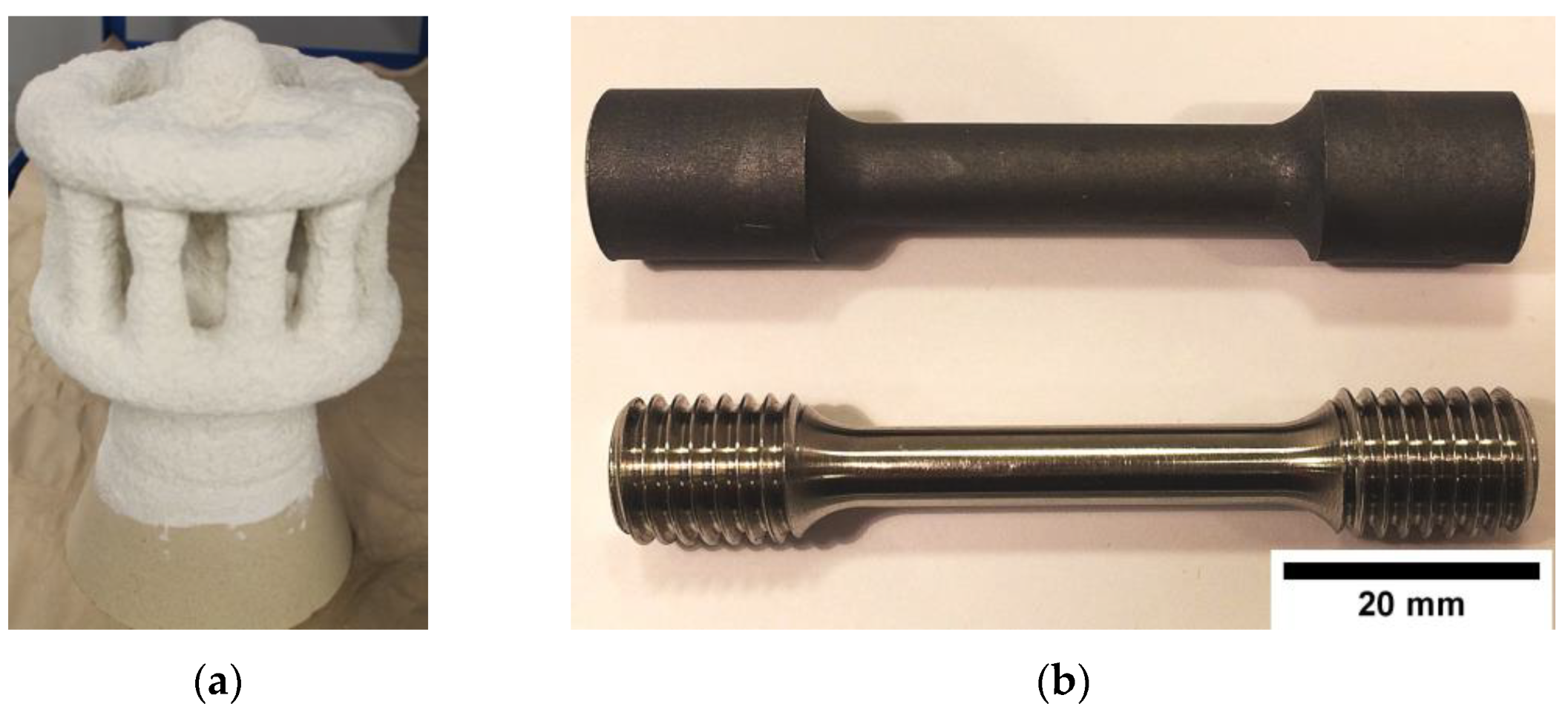
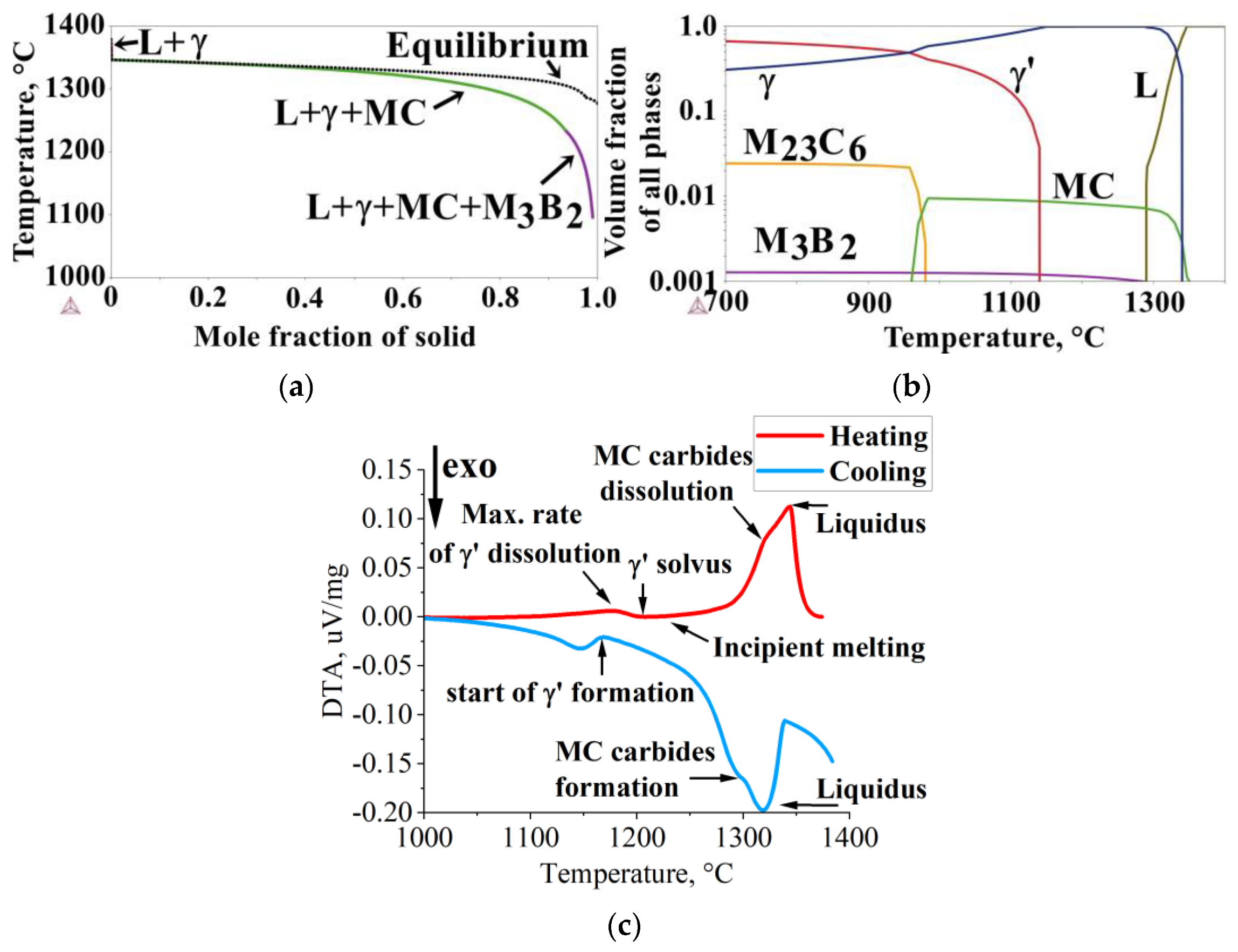
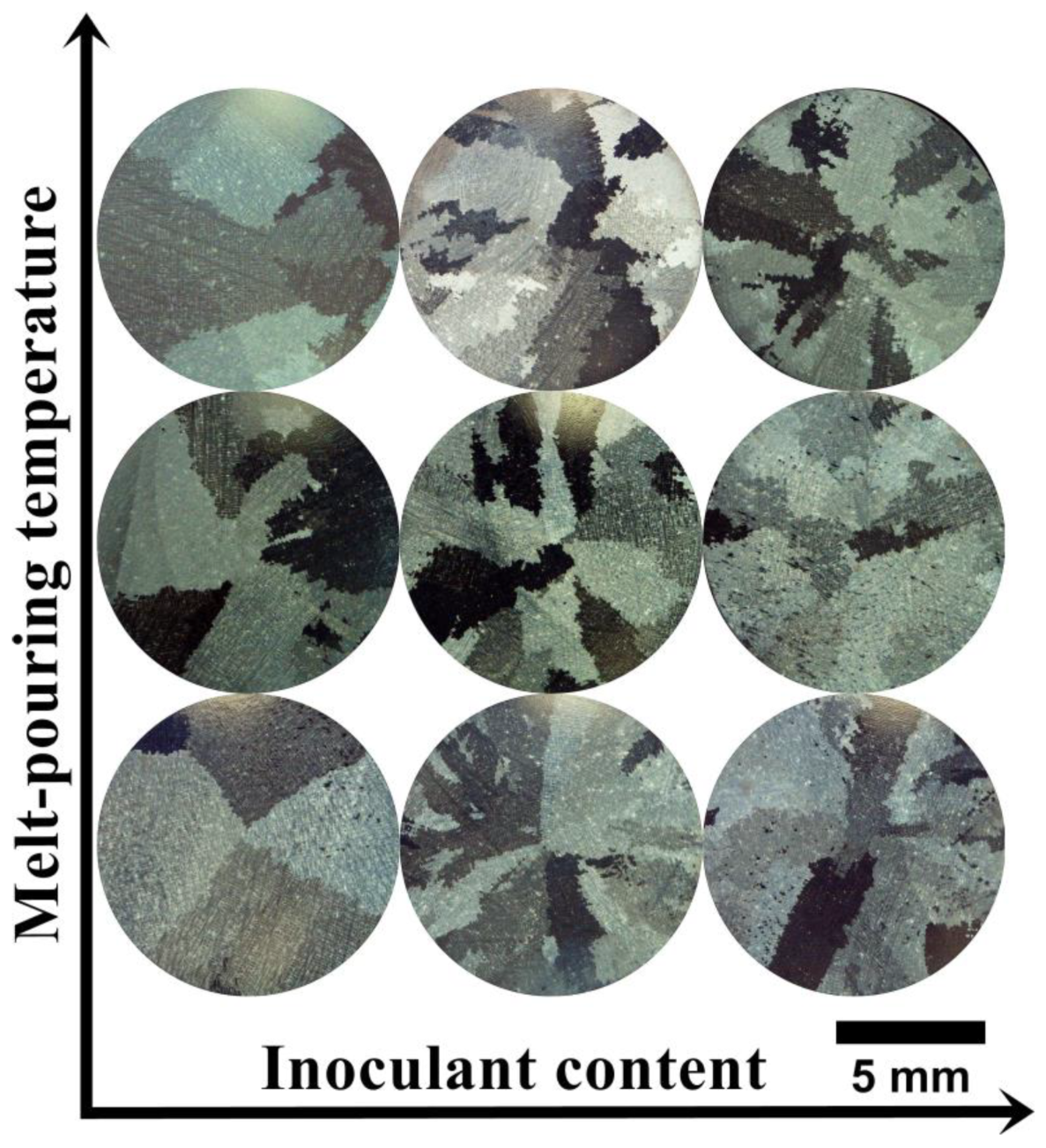
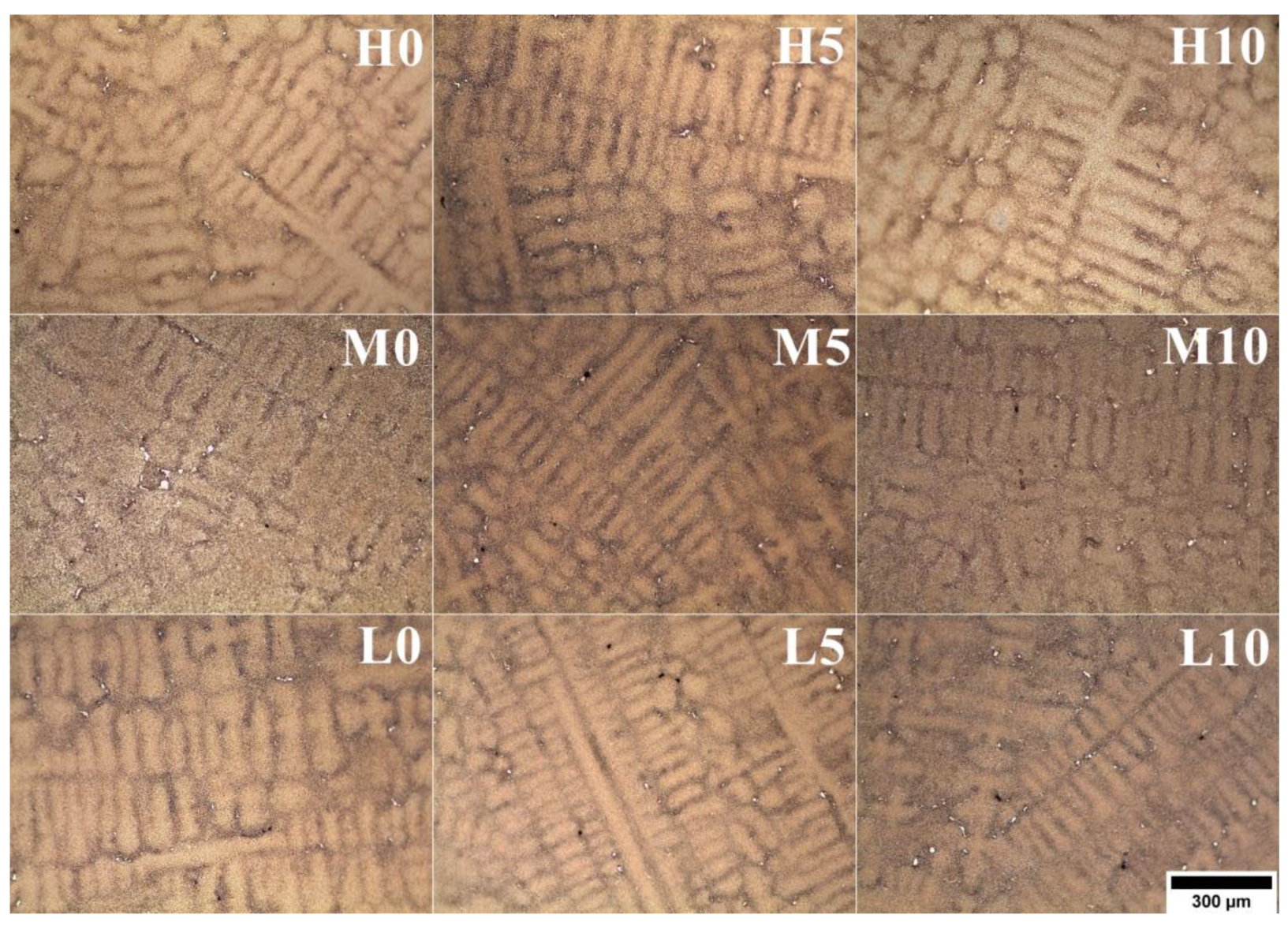


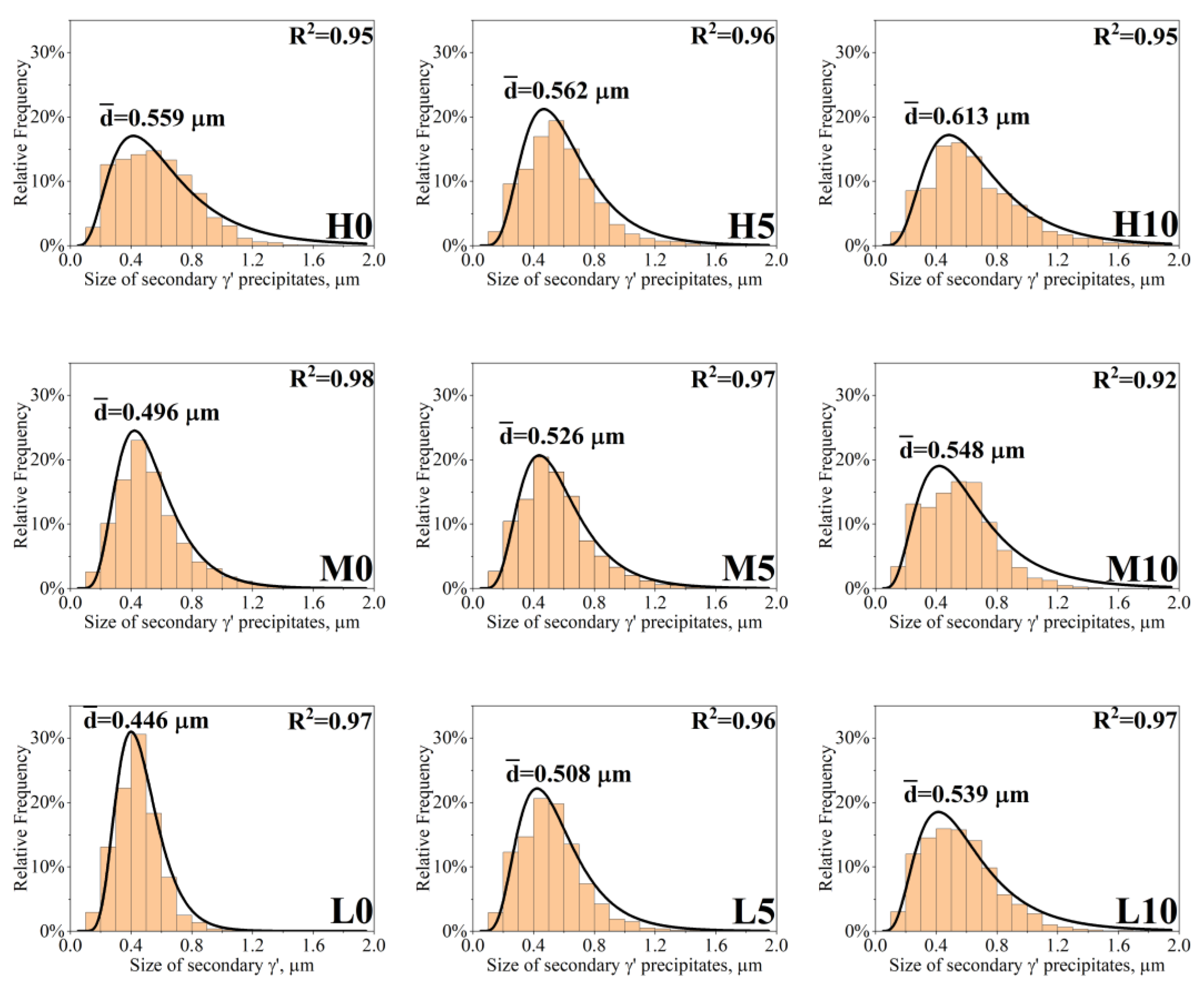
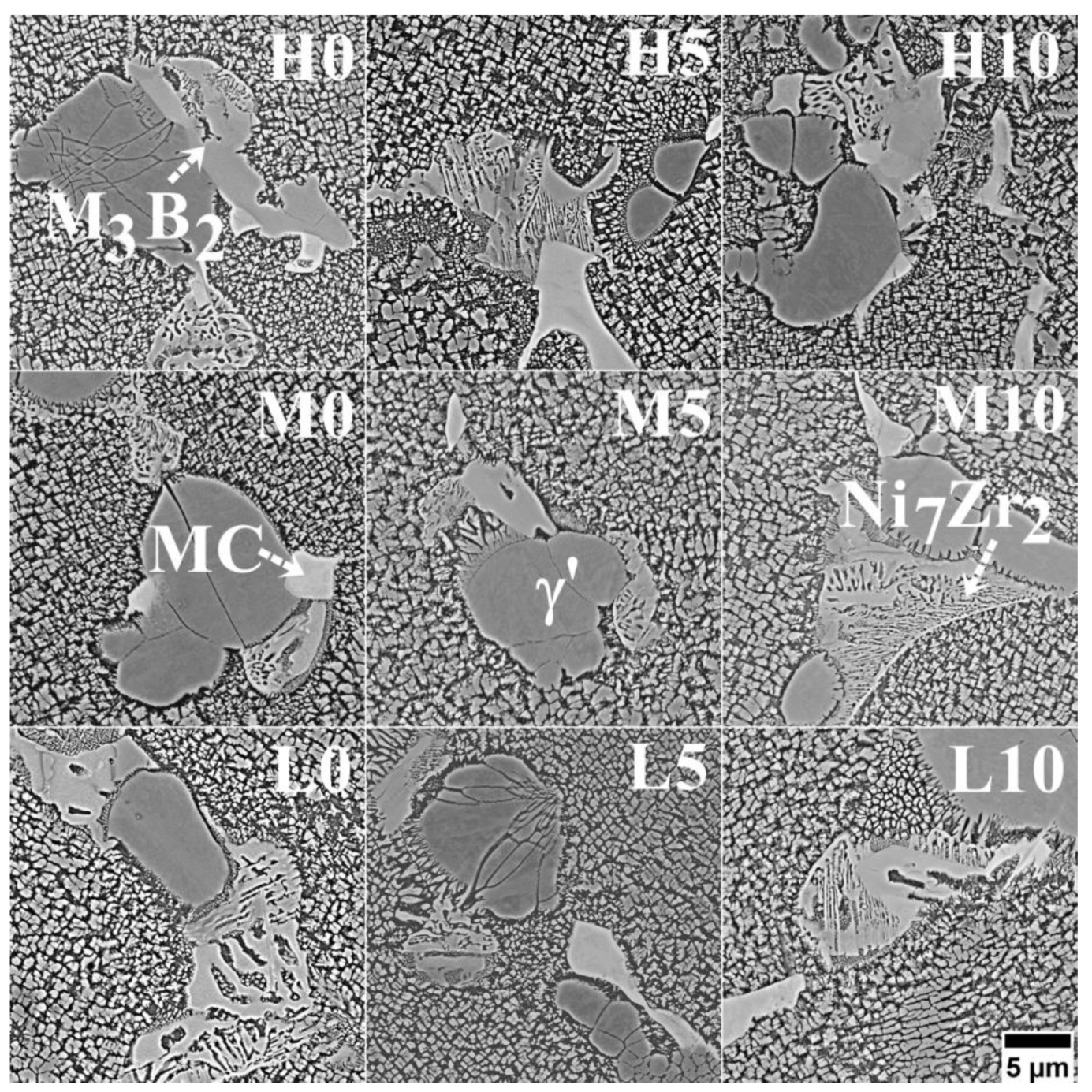

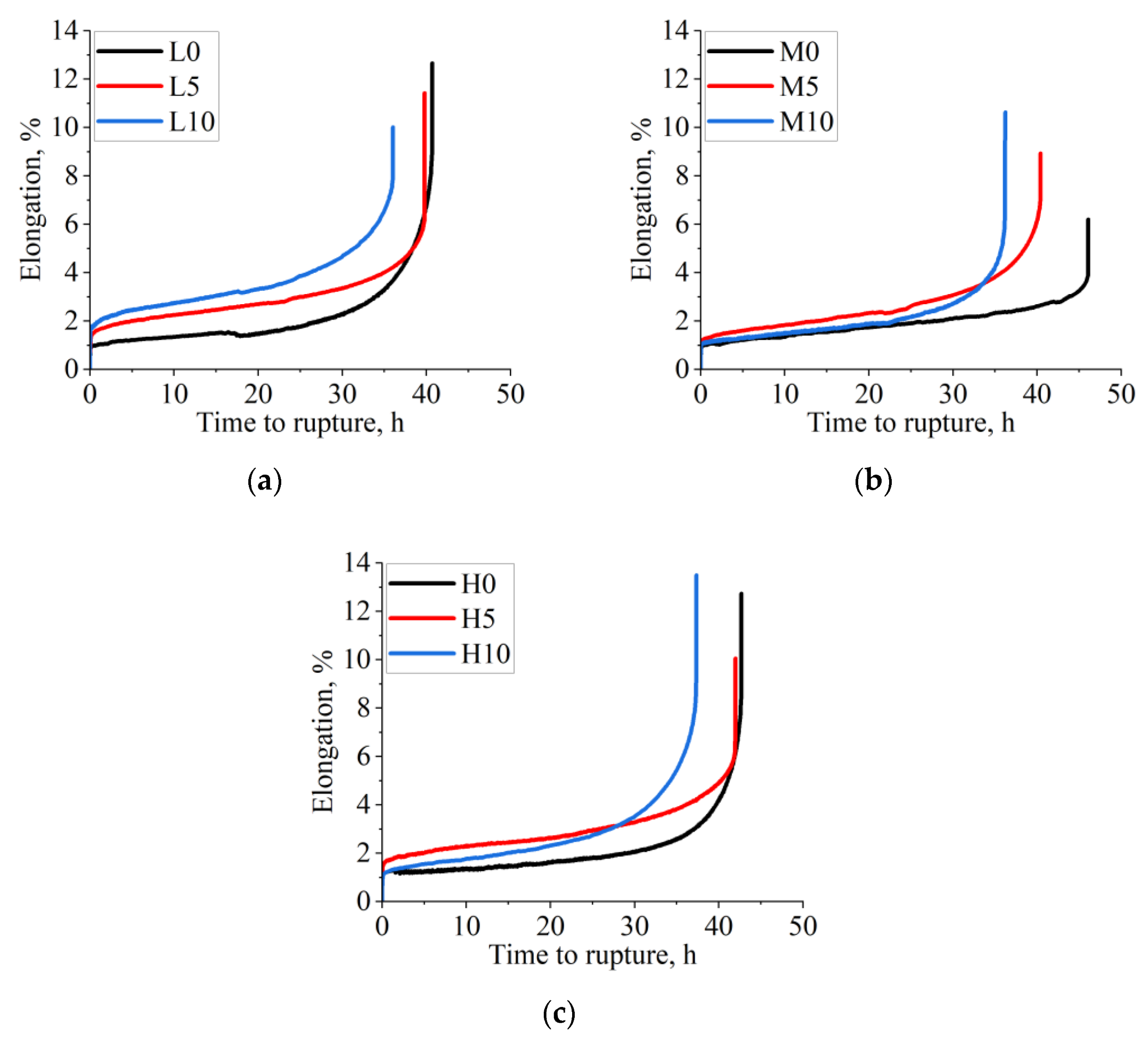
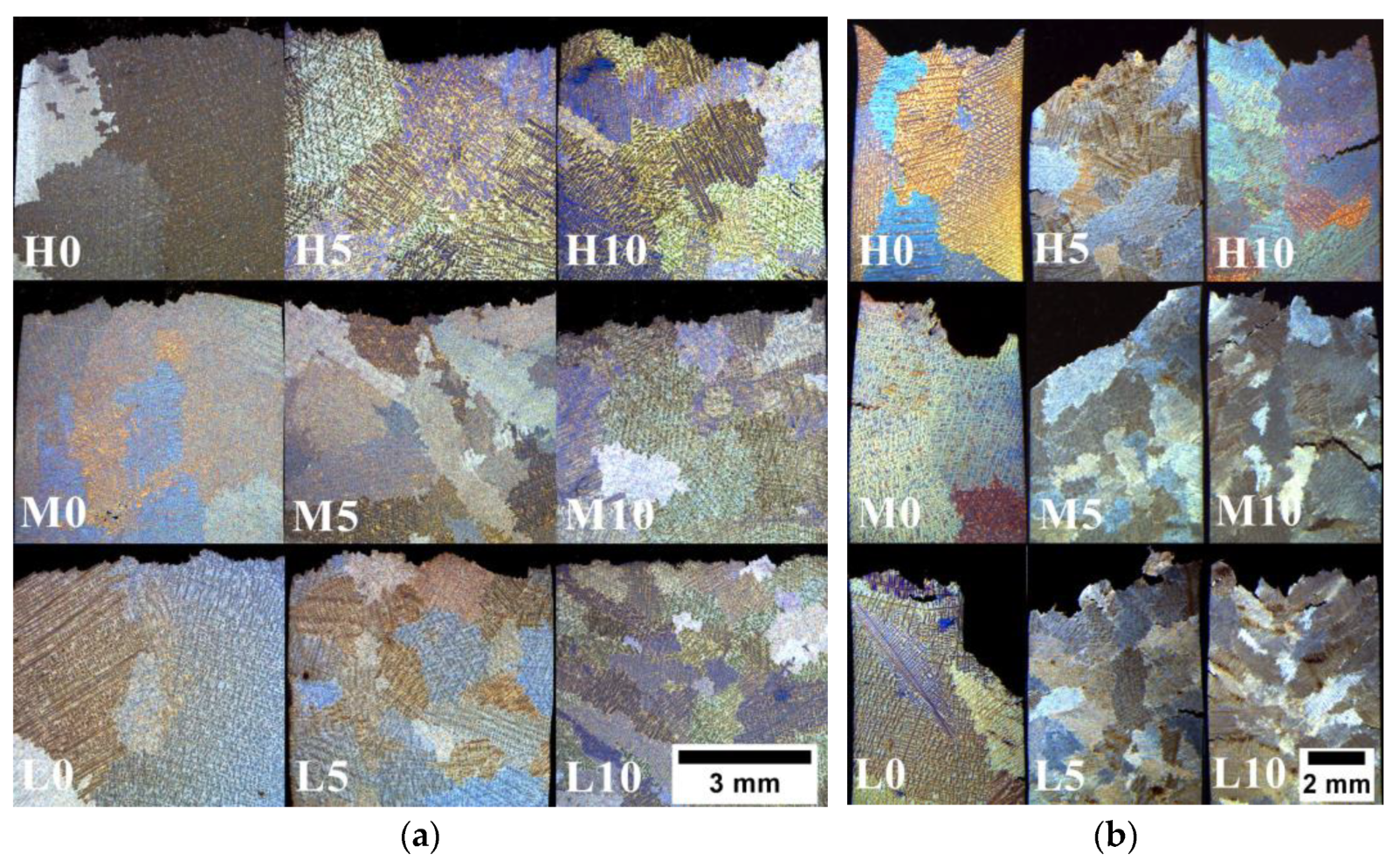
| Casting | Pouring Temperature, °C | Inoculant Content, wt% | Shell Mold Temperature, °C |
|---|---|---|---|
| L0 | 1450 | 0 | 1150 |
| L5 | 5 | ||
| L10 | 10 | ||
| M0 | 1480 | 0 | |
| M5 | 5 | ||
| M10 | 10 | ||
| H0 | 1520 | 0 | |
| H5 | 5 | ||
| H10 | 10 |
| Pouring Temperature, °C | CoAl2O4, wt% | Grain Size, mm | SDAS, μm |
|---|---|---|---|
| 1450 | 0 | 4.40 (±3.56) | 63 (±7) |
| 5 | 3.77 (±4.75) | 63 (±5) | |
| 10 | 2.44 (±2.41) | 66 (±4) | |
| 1480 | 0 | 3.18 (±3.34) | 69 (±5) |
| 5 | 2.68 (±2.57) | 69 (±5) | |
| 10 | 2.40 (±2.07) | 72 (±5) | |
| 1520 | 0 | 6.55 (±3.73) | 72 (±8) |
| 5 | 2.45 (±2.62) | 77 (±7) | |
| 10 | 2.36 (±2.32) | 77 (±6) |
| Pouring Temperature, °C | CoAl2O4, wt% | YS, MPa | UTS, MPa |
|---|---|---|---|
| 1450 | 0 | 787 (±21) | 879 (±14) |
| 5 | 813 (±2) | 1010 (±7) | |
| 10 | 835 (±6) | 994 (±28) | |
| 1480 | 0 | 783 (±23) | 877 (±5) |
| 5 | 828 (±1) | 984 (±6) | |
| 10 | 814 (±2) | 970 (±21) | |
| 1520 | 0 | 775 (±8) | 868 (±18) |
| 5 | 804 (±14) | 947 (±46) | |
| 10 | 819 (±8) | 967 (±14) |
Disclaimer/Publisher’s Note: The statements, opinions and data contained in all publications are solely those of the individual author(s) and contributor(s) and not of MDPI and/or the editor(s). MDPI and/or the editor(s) disclaim responsibility for any injury to people or property resulting from any ideas, methods, instructions or products referred to in the content. |
© 2023 by the authors. Licensee MDPI, Basel, Switzerland. This article is an open access article distributed under the terms and conditions of the Creative Commons Attribution (CC BY) license (https://creativecommons.org/licenses/by/4.0/).
Share and Cite
Cygan, R.; Rakoczy, Ł. The Effect of CoAl2O4 as a Nucleating Agent and Pouring Temperature on the Microstructure and Properties of Inconel 713C® Nickel-Based Superalloy Castings. Materials 2023, 16, 5588. https://doi.org/10.3390/ma16165588
Cygan R, Rakoczy Ł. The Effect of CoAl2O4 as a Nucleating Agent and Pouring Temperature on the Microstructure and Properties of Inconel 713C® Nickel-Based Superalloy Castings. Materials. 2023; 16(16):5588. https://doi.org/10.3390/ma16165588
Chicago/Turabian StyleCygan, Rafał, and Łukasz Rakoczy. 2023. "The Effect of CoAl2O4 as a Nucleating Agent and Pouring Temperature on the Microstructure and Properties of Inconel 713C® Nickel-Based Superalloy Castings" Materials 16, no. 16: 5588. https://doi.org/10.3390/ma16165588






